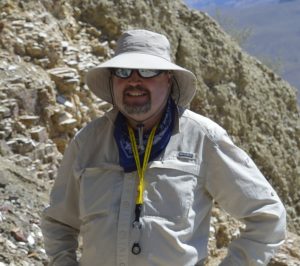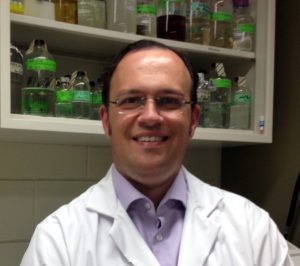BRANDON, Man. – Cutting-edge research at Brandon University (BU) has received a huge boost, with the announcement of five new Discovery Grants, worth a total of $660,000 over five years, awarded to members of the Faculty of Science.
The grants, awarded by the Natural Sciences and Engineering Research Council of Canada (NSERC), bring the number of Discovery Grant projects led by BU researchers to 9. In each of the previous four years, one member of the Faculty of Science has been awarded a Discovery Grant.

“This increase in the number of NSERC funded research projects in science is unprecedented and historic for BU,” said Dr. Austin Gulliver, Dean of Science. “It is a tremendous accomplishment for any small university and reflects the superb research being conducted here. Our Faculty of Science and our entire University community can take enormous pride in this success.”
New Discovery Grant recipients include Dr. Bryan Cassone, Dr. David Greenwood and Dr. Christophe LeMoine from the Department of Biology as well as Dr. Eric Bushnell and Dr. Michael Charette from the Department of Chemistry.
“These NSERC funds will allow us to hire summer undergraduate students and graduate students and provide them with a world-class experience in research,” said Dr. Charette.
“While the funding improves our ability to conduct research, it is that ability to hire students and give them that unique research exposure that is truly a game-changer.”
Their research projects will advance knowledge in varied areas, such as Eocene ecosystems, virus transmission, molecular chemistry and genetic function.
“It is excellent that a remarkable number of BU researchers have been recognized for their outstanding contributions to the field of science in Canada,” said Dr. Heather Duncan, Associate Vice-President (Research). “Their efforts will advance Brandon and Manitoba as a centre of research excellence, which will benefit our retention of talent, attraction of investment and create opportunities in the province.”
Other BU faculty having their research supported by ongoing Discovery Grants awarded in previous years are Dr. Bernadette Ardelli (Biology, year 2 of 5), Dr. Sarah Plosker (Mathematics and Computer Science, year 3 of 5), Dr. Wendy Untereiner (Biology, year 4 of 5) and Dr. Meg Carrington (Physics, year 5 of 5).
“It’s thrilling to have such a diverse set of scholars representing Brandon University with excellent research in so many different areas,” said Dr. Steven Robinson, Vice-President (Academic & Provost). “One of the real advantages of a close-knit university like BU is the ability to rub shoulders with researchers in different fields. There are so many great opportunities here for sharing between our faculty and with our students.”
Discovery Grants, which are typically awarded for a period of five years, support long-term projects in the natural sciences and engineering at Canadian universities.


Research summaries
Eric Bushnell
The chemistry of metal-diselenolene complexes ($22,000 annually)
The combination of ligand non-innocence and reversible redox behaviour of metal-dithiolene complexes results in unique electrical, optical, magnetic and conductive properties. Because of these properties dithiolene-containing complexes have been investigated for potential use in the partitioning of spent nuclear fuels, the purification of olefins in the production of polymers, dye-sensitized solar cells, catalysts for the photo splitting of H2O, magnetic materials, chemical microsensors, optical limiting devices, and more recently in the treatment of cancer. Thus, given the rich and diverse chemistry of dithiolene complexes it is not surprising that they remain a subject of high interest. While past research has shown parallels in the chemistry of diselenolene and dithiolene complexes significant difference also exist which warrants further research into diselenolene complexes. Hence, using a combination of computational tools the role of these diselenolene complexes in bioinorganic chemistry as well as in materials science will be investigated. In particular, density functional theory (DFT) will be used to investigate the structures, reduction potentials and HOMO-LUMO gap energies of diselenolene complexes. Using time-dependent DFT the photochemistry of diselenolene complexes will be examined. Notably, mixed ligand diimine-metal-dithiolene complexes have been investigated for use in dye-sensitized solar cells and to the photo splitting of H2O to form H2. Regarding dithiolene containing enzymatic systems the biomimetic diselenolene analogues will be investigated using a combined quantum mechanics/molecular mechanics (QM/MM) approach. Natural bonding orbital (NBO) analyses will be performed to provide greater insight into the effect of substituting the S with Se on the electronics of the system.
Bryan Cassone
Genetic Basis of Coleopteran Vectorial Capacity for Bean pod mottle virus Transmission ($29,000 annually)
Why do some leaf–feeding arthropods transmit plant pathogens while others do not? Moreover, why typically are only a small minority of individuals within a vector species proficient at transmitting a particular pathogen? A considerable number of coleopteran beetles transmit viruses that cause disease to economically important vegetables and crops. However, the degree of variation within and among beetle species in their ability to harbor and transmit pathogens is remarkable (i.e. their vector competence). The genetic makeup of the vector undoubtedly contributes significantly to its susceptibility to pathogen infection and transmission, yet characterization of specific genes that influence vector competence has proven elusive. The long–term goal of the proposed research is to understand the genetic interactions and mechanisms of pathogen transmission by insects. Identifying genes that disrupt vector-mediated pathogen transmission will lead to novel and promising avenues for disease control. The proposed research will harness the unique attributes of a soybean pathosystem, consisting of three beetle species that exhibit individual and species level variation in their ability to vector a soybean virus that is prevalent in North America, Bean pod mottle virus (BPMV).
Michael Charette
Molecular characterization of the function and regulation of the subcomplexes of the ribosomal small subunit processome in ribosome assembly in the yeast model organism Saccharomyces cerevisiae ($29,000 annually)
Ribosomes are tiny molecular machines that are present by the hundreds of thousands in all cells. They play an essential role in every aspect of life, as they are the link between the genome (or DNA) and proteins. Ribosomes “read” genetic information and translate it into the corresponding protein. In turn, proteins provide the cell with architectural and structural support, the ability to move (such as muscle contraction), and often themselves act as miniature molecular motors in providing the cell with the ability to use energy, to grow, and to divide. These are all key aspects to the normal day-to-day life of a cell. We have an increasingly sophisticated understanding of how ribosomes read genetic material and assemble the corresponding protein, much like we understand well the internal combustion motor of a car. The research proposed here looks at how the ribosome is assembled and at another miniature molecular machine, called the SSU processome, which assembles part of the ribosome. That is akin to saying that our interests are in how cars are assembled and how car assembly lines work.
David Greenwood
Forest communities in transition: Eocene fossil sites from western and Arctic Canada ($25,000 annually)
North American temperate forests in the geological past shared many plant genera with east Asia and Europe (e.g. Pseudolarix, Acer, Sassafras, and Trochodendron). Exchange between these geographic regions is not possible today as the dispersal corridors have been too cold for 3-15 million years. Climate warming episodes in the geological past, however, facilitated biotic exchange between them. The fossil record provides a primary record of the presence of plant taxa and of climate in the past. The proposed work will focus on the early Eocene epoch (ca. 56–47.8 MYA) when much of North America supported a tropical fauna and flora, midlatitude mean annual temperatures (MAT) were ca. 20°C with mild frost-free winters, and even the Arctic hosted alligators. These warm high latitude early Eocene climates opened a northern dispersal route for plants and animals via the Arctic. Fossil localities in British Columbia present the only record of the Eocene from Canada outside the Arctic ranging from cool (MAT 10–12°C) elevated upland lake sites that supported forests of mixed temperate and tropical biota, to warm (MAT 15–20°C) lowland environments on the Pacific coast of BC and WA that included palms. The proposed research program has these long term objectives: (1) Develop a synthesis of changes in forest communities through time, i.e., dominance, diversity and first appearances (origination of lineages), both within and between fossil sites; (2) Determine regional and temporal patterns of biotic diversity, and its relation to change in climate, i.e. the biotic consequences of past climate change and climate as an evolutionary driver. Short term objectives are focused on: (1) the McAbee fossil beds and targeted sites elsewhere in BC to reconstruct paleoenvironments; (2) completion of analyses of existing collections of Arctic Eocene sites; and (3) systematic analysis of these sites expanding as opportunity allows to include other plant fossil sites from British Columbia to broaden the scope both temporally and spatially to cover more of BC.
Christophe LeMoine
Determinants of metabolic plasticity in vertebrates ($27,000 annually)
Cellular energy is essential to life, and the identification of the regulatory pathways orchestrating both its synthesis and utilization presents an intricate puzzle at the molecular, biochemical, and organismal levels. Within an ecophysiological context, the adequate modulation of these regulatory mechanisms is essential for the acclimatization and survival of species in their environment. A particularly complex problem facing organisms is the maintenance of mitochondrial function, as the various components of this organelle are either encoded on the nuclear or the mitochondrial genomes. Thus to make a functional organelle, expression of hundreds of genes from the two genomes must be coordinately regulated. In mammals, this
coordination is intricate and involves a plethora of transcription factors and their coactivators. However, while extensive work has been performed in mammals, relatively little is known about these mechanisms in other taxa. In particular, previous research suggests fundamental divergences in the regulation of mitochondrial phenotype in other vertebrates such as fish. The long-term goal of my research is to understand the mechanisms of metabolic plasticity, and how they are recruited in response to developmental and environmental cues. Further, I am interested in the dynamic evolutionary trajectory of these regulatory networks in vertebrates. My research program takes an integrative approach to investigate these regulatory patterns relating molecular processes (gene expression) to tissues and whole animal metabolism.
Contact
- Brandon University
- communications@brandonu.ca
To receive any BU publication in an alternate format please contact Communications@BrandonU.ca
About BU
Success is built at Brandon University. Our growing, progressive campus welcomes a diverse and inclusive community that combines proud tradition with shared ambition. Through our excellence in teaching, research, and scholarship, we educate students to make a meaningful difference as engaged citizens and leaders. Join us at BrandonU.ca.